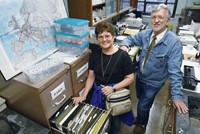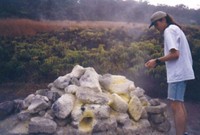Advertisement
Grab your lab coat. Let's get started
Welcome!
Welcome!
Create an account below to get 6 C&EN articles per month, receive newsletters and more - all free.
It seems this is your first time logging in online. Please enter the following information to continue.
As an ACS member you automatically get access to this site. All we need is few more details to create your reading experience.
Not you? Sign in with a different account.
Not you? Sign in with a different account.
ERROR 1
ERROR 1
ERROR 2
ERROR 2
ERROR 2
ERROR 2
ERROR 2
Password and Confirm password must match.
If you have an ACS member number, please enter it here so we can link this account to your membership. (optional)
ERROR 2
ACS values your privacy. By submitting your information, you are gaining access to C&EN and subscribing to our weekly newsletter. We use the information you provide to make your reading experience better, and we will never sell your data to third party members.
Education
Newscripts
Our Town Is Elemental
by Bethany Halford
January 18, 2010
| A version of this story appeared in
Volume 88, Issue 3

While navigating his way through Kentucky a few years back, Nicholas C. Thomas was surprised to find two noble gases on his road atlas. The eastern region of the Bluegrass State is home to the villages of Krypton and Neon, about 50 miles apart. Thomas, a chemistry professor at Auburn University, in Montgomery, Ala., wondered what other elementally named hamlets might be scattered about. "I guess I've always been interested in finding examples of chemistry in unusual places," he tells Newscripts.
By plugging the elements into the database of the U.S. Board on Geographic Names' website (geonames.usgs.gov), Thomas was able to find a wealth of towns named for various elements. "Gold," for example, appears in the name of some 2,000 locations throughout the country.
Thomas published a sampling of the elemental towns he discovered, along with their histories, in the Journal of Chemical Education (2009, 86, 181). "Understanding the origin behind the naming of these towns provides students with an interesting way to connect chemistry with U.S. history and geography," he notes.

Travelers to Bryce Canyon National Park might consider taking a 40-mile detour north to Antimony, Utah. Although it's now a quiet ranching and vacation community, Antimony was once home to Butch Cassidy. The town was originally named Coyote when it was settled by cattle ranchers, but the discovery of stibnite—Sb2S3—eventually led to an antimony-mining operation and a new name.
Barium Springs, N.C., was once known as Poison Springs because cattle refused to drink from the local mineral pools. That old name might have come as a shock to customers of a company known as the Great Human Repair Shop, which sold the local waters as a health tonic throughout the country and overseas until the end of World War I.
With a nod toward the alchemical, Lead, S.D., is home to the Homestake mine, which was the largest, deepest, and most productive gold mine in the Western Hemisphere until it was shuttered in 2001. Thomas notes that you'll have to suppress your chemical instincts if you want to fit in with the locals, whose pronunciation of the town's name rhymes with "seed."
Blink and you might miss the 1.2-acre patch of the Show-Me State known as Lithium. There's still a sign to indicate the tiny, now uninhabited Missouri town.

Many of the towns listed in Thomas' paper derive their names from local mineral deposits, but the town of Calcium, N.Y., is an exception. As it turns out, Thomas had to be something of a sleuth to learn how this hamlet of 3,000 residents got its name. Very little information about Calcium is readily available, he tells Newscripts. It was only when he placed a cold call to the Calcium Community Church that Thomas was able to learn the history of the town's name from the local pastor.
In the early 1900s, a local resident named Madison Cooper successfully petitioned to have the town's name changed from Sanford's Corner. It was a somewhat extreme move born out of the frustration of having his mail frequently sent by mistake to Stanfordville, N.Y. Cooper worked in cold storage and refrigeration and chose to name his hometown for the calcium chloride used in his trade. Also on the plus side regarding his postal problems: No other town in the country was named Calcium.
In the course of his investigation, Thomas got to thinking that it might be fun to take an elemental road trip—in his Chevy Cobalt, of course. The idea, however, was quickly shot down by his wife.








Join the conversation
Contact the reporter
Submit a Letter to the Editor for publication
Engage with us on Twitter